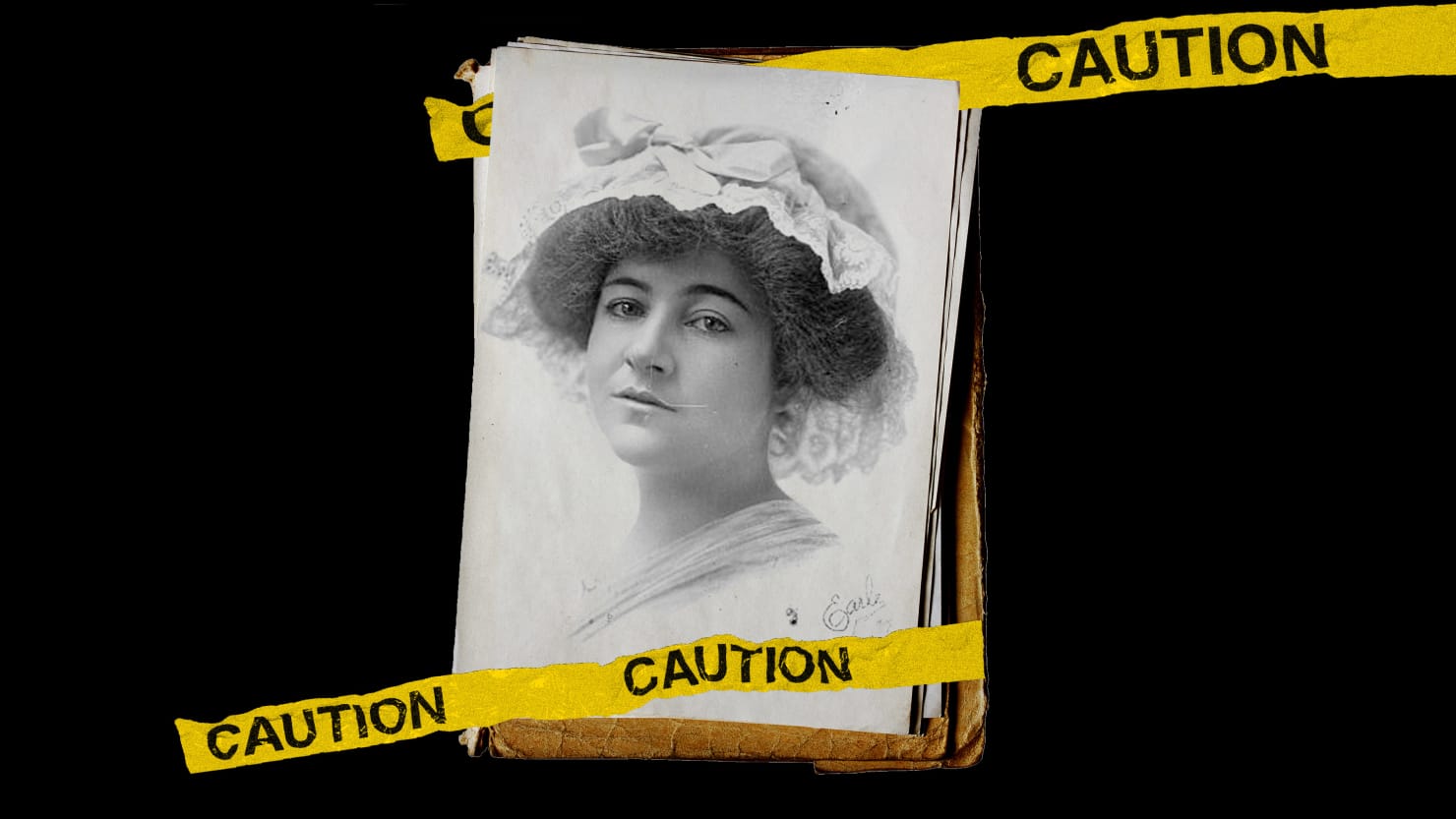On December 12, 1910, 25-year-old Dorothy Arnold left the Upper East Side home she shared with her parents to enjoy what everyone around her thought would be just another ordinary day of a young heiress about town. Naturally, she was dressed to the nines.
Dorothy wore a navy blue serge suit with a high neck white lace jabot (a Victorian-style ruffled piece). Her hands were covered in tan gloves and she carried a large black fox fur muff for extra warmth. It doubled as a safe place to stash the $25 she had of her monthly allowance as well as whatever money remained from the $36 she had withdrawn from the bank for a luncheon the previous day. Her dark brown hair was in a “full pompadour” covered by a large black velvet hat. She accessorized her look with lapis lazuli drop earrings, a gold twist “lovers knot” ring, an imitation tortoise shell comb, and a carved barrette.
You wouldn’t be wrong to think this sounds like a report from one of the day’s illustrated issues of Vogue. We know what she was wearing because, when she failed to return home, a detailed drawing of her “costume” eventually ran in the papers looking eerily like a fashion spotlight on a woman about town.
Dorothy told her mom she was off to shop for a dress to wear to her sister’s coming out party, though when her steps were later tracked, they didn’t go near the proverbial racks. Whether she failed to make it that far or whether she followed the time-honored tradition of fibbing to your parents about where you’re actually going, we’ll never know.
What she did do is brave the bracing air of a Manhattan December day to walk 52 blocks down Fifth Avenue, first stopping to buy some chocolates (charged to the family tab) before ending up at a bookstore where she ran into a close friend, who later reported nothing seemed amiss.
After that, she vanished.
It’s been over 100 years since Dorothy Arnold went missing and it’s safe to say the trail has gone as cold as that December day. While rumors have never died down as to the mystery of the missing heiress, not one shred of evidence has suggested an answer to the question that plagued a family and a city for over a century.
“Mother will always think an accident has happened”
In the wake of her disappearance, Dorothy was, by all accounts, the picture of a (mostly) proper young lady. She had plenty of friends, socialized as a good socialite should, and did more than keep up appearances. She followed the dictates of dear mum and dad and did what every good girl was supposed to do, though one does have to wonder if her parents were chapped that their daughter was still unwed (the average age of marriage for women at the time was around 21).
But the silence of history echoes when it comes to the inner lives of young women of that period, especially when their papers are mysteriously burned (more on that later). What is known is that Dorothy was a happy coed, having graduated from Bryn Mawr, and that she had dreams of living the bohemian life of a writer. Her family was not supportive.
Her father came from money and made considerably more of it as a partner at F.R. Arnold & Co., an importer whose main product was perfume and cologne. When he died in 1924, he would leave nothing to his missing daughter, who he had long since believed was dead. But that was nearly 15 years off and he had enough money in 1910 that when reporters finally got wind of the missing girl, they went ahead and dubbed her an “heiress.”
Being an heiress is nice and all, but Dorothy wanted to be a writer. To that end, she asked her parents for permission to move into an apartment in Greenwich Village, presumably to be where the other creative people were. The answer was a categorical “no.” Mr. Arnold brushed off her dreams of independence with the short pronouncment that: “A good writer can write anywhere.”
So that’s what Dorothy did. She wrote a short story and submitted it for consideration at McClure’s. It was then that Dorothy made a decision that would come to haunt her: she told her family. A 1960 story in American Heritage recounts that they “all began teasing her unmercifully about her literary pretensions.” As is the experience of most first-time writers, her story was politely rejected. But Dorothy received that rejection while living at home with no support for her dreams. “In the words of a news account, ‘Dorothy now found life a torment among her amused relatives.’”
So not all was fox fur muffs and roses for the Upper East Side heiress. But there was one other area in which she had defied her family’s expectations: love. Dorothy had the gall to enter into a relationship with a man that was definitely not approved.
George C. Griscom, Jr. was 42 when Dorothy went missing. It’s hard to imagine what Dorothy saw in the man other than a chance at a little independence and rebellion. Not only was he much older than the woman he met as a student, but he didn’t have a lot going for him in either the looks or the personality department. He was a dumpy middle-aged man who still lived at home and whose life consisted mostly of following his parents around.
Despite the restrictions on a young lady of Dorothy’s stature, the two still managed to steal away over the years, the most recent liaison occurring the summer before Dorothy went missing. Despite the subterfuge (that summer jaunt was allowed under the ruse that Dorothy was visiting a friend from college), it later became known that Dorothy’s parents had gotten wind of “Junior” and were not happy.
When asked about his restrictions on his daughter’s love life in the press conference announcing her disappearance, Mr. Arnold became enraged: “It is not true that I objected to her having men call at the house. I would have been glad to see her associate more with young men than she did, especially some young men of brains and position: one whose profession or business would keep him occupied. I don’t approve of young men who have nothing to do.”
But Griscom wasn’t the only one whose actions veered into shady. In the initial days after Dorothy failed to make it home, her family seemed more focused on protecting their reputation than finding their daughter.
The minute Dorothy didn’t show for dinner, the Arnolds knew that something was wrong. They phoned several of her friends, ending their calls with a request not to share that their daughter was missing. When one of the friends called back a few hours later to inquire if Dorothy had been found, she was told Dorothy was now home, but that she couldn’t come to the phone because “she had a headache and went right to bed.”
The family didn’t go to the police—they claimed they didn’t want the publicity. Instead, they called on a lawyer friend of Dorothy’s older brother who was asked to play something of a detective role. One of the things he found when he initially searched her room was a pile of now-unrecognizable papers smoldering in the fire. The family claimed she must have burned her latest unsuccessful manuscript.
When the young lawyer turned up no clues, the Arnolds hired the Pinkertons. It was the renowned detective agency that finally convinced them to publicize the disappearance. Six weeks after Dorothy walked out of the house, they finally reported her missing to the NYPD.
“Dorothy must be the well-to-do young lady who showed up at a Boston hospital with amnesia. It was her body pulled out of the East River. No, she was selling shoe polish in Chicago…”
It was then that Dorothy’s disappearance swept the nation. The police insisted that Mr. Arnold make a statement to the press publicly announcing the search for his daughter. He offered a $1000 reward, and the tips started rolling in.
Dorothy must be the well-to-do young lady who showed up at a Boston hospital with amnesia. It was her body pulled out of the East River. No, she was selling shoe polish in Chicago or she was in Richmond sending secret telegram messages to a friend in Atlantic City. Scratch that, she was living in L.A. under a different name, or she was the rich woman found in a Philadelphia sanitarium.
Reading the coverage, it’s a wonder how many affluent young ladies of unknown identity were languishing in U.S. hospitals in 1911. But it seems that each and every one was suspected to be Dorothy Arnold.
Her family followed every lead. At one point it was reported that her mother had gone missing, only for Mrs. Arnold to turn up in Europe on the hunt for her daughter. As the days ticked by and no shred of evidence was found, the speculation set in.
First, there were those who believed that Dorothy, fed up with the restrictions at home, decided to take her life into her own hands. She pulled together the little money she had on hand, told her parents she was off to run errands, and then left with nothing more than the clothes on her back to start a new life for herself. This theory was bolstered by a river front merchant who claimed that “a mysterious young woman of apparent refinement” had tried to give him her jewelry in exchange for clothes to disguise herself as a man.
The more bleak take on the dissatisfied heiress theory was that she committed suicide in a state of dejection about her failure as a writer. A letter she had recently written to Griscom had the puzzling line, “Mother will always think an accident has happened.”
“It’s hard to believe that any one of these scenarios could have left no mark in the 100 years since Dorothy disappeared.”
Speaking of Griscom, some thought she had run away to be with him. He was in Europe at the time of her disappearance—naturally with his parents—and professed no knowledge of her whereabouts. He then very publicly came back to the States to help with the search. A darker side to the speculation about his involvement suggests Dorothy had died in the course of getting a back-alley abortion, and that he had put on a front and stayed silent about the tragedy.
And finally, there was her stalwart father. While his wife and son ran around the world chasing leads, Mr. Arnold became convinced early on that Dorothy had been kidnapped and murdered, probably in Central Park. While his contention that her body was dumped in the reservoir was unfounded—it was frozen at the time and no body has ever turned up—he believed from the early days of the investigation that Dorothy had somehow been taken in plain sight, in the middle of a crowded city, and killed.
The fact is, any one of these theories could be true. Each is equally plausible, as well as equally puzzling. It’s hard to believe that any one of these scenarios could have left no mark in the 100 years since Dorothy disappeared.
The only fact that is known for sure is that one day, a 25-year-old heiress with dreams of being a writer went out for a walk. Like a whiff of perfume, she vanished in thin air.






